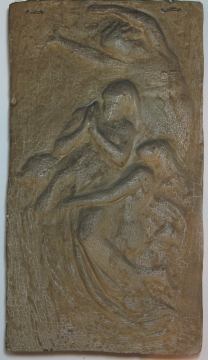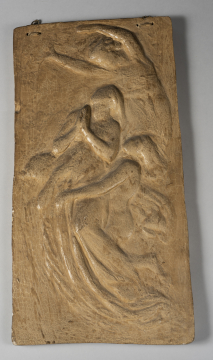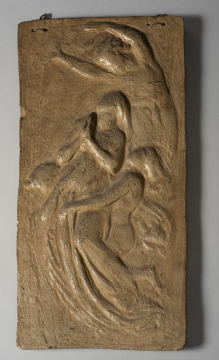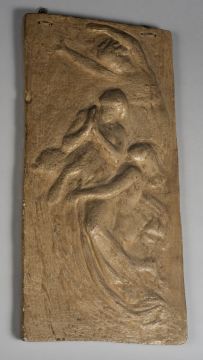Explore Collections


You are here:
CollectionsOnline
/
Bas relief, model for the monument to Agnes Cromwell
Browse
John Flaxman's plaster model for the monument to Agnes Cromwell. SM M1077. ©Sir John Soane's Museum, London. Photo: John Bridges
John Flaxman RA (1755 - 1826), sculptor
Bas relief, model for the monument to Agnes Cromwell
c.1797-98 (the marble monument is dated 1800)
Plaster
Height: 51cm
Width: 27cm
Depth: 2cm
Width: 27cm
Depth: 2cm
Museum number: M1077
Not on display
Curatorial note
Model for the relief on Flaxman's marble monument to Agnes Cromwell in Chichester Cathedral, Sussex. The monument is a wall tablet inscribed Come thou Blessed [above the relief] / Sacred to the memory of / Agnes Sarah Harriet / daughter of Henry Cromwell Esq: Captn R.N. / and Mary his wife / who died on the 30th day of November 1797 / in the 18th year of her age [below the relief]. On the monument this relief is set within a tabernacle. It depicts the spirit of the dead girl, with hands folded in prayer 'floating heavenwards with an escort of angels arranged gracefully in a reversed s, and, inspired ...by the nymphs who adorn the sides of the marble vases of antiquity' (Penny, 1977). The monument was completed by winter 1798 but in November 1799 Flaxman was still waiting for instructions from Agnes' father as to the Epitaph [Letter from Flaxman to Hayley, 27 Nov 1799, Fizwilliam Museum, Cambridge, Flaxman correspondence]. It seems likely, therefore, that this model dates from 1797-98. The finished work, which is in considerably higher relief was exhibited at the Royal Academy in 1800 (no.1056) under the title 'Come thou blessed: a marble bas-relief'.
There is another plaster sketch-model for this monument titled “Come thou Blessed” (plaster, 52 × 26 cm) in the Flaxman collection at University College, London. In the Rosenwald Collection, National Gallery of Art, Washington DC, USA, is a pencil drawing by Flaxman which is catalogued as possibly for the Agnes Cromwell monument and dated c.1798-1800.
The Cromwell monument was an extremely influential work with the motif of the spirit ascending imitated by almost all major British sculptors over the next 50 years - usually on monuments to women.
There is another plaster sketch-model for this monument titled “Come thou Blessed” (plaster, 52 × 26 cm) in the Flaxman collection at University College, London. In the Rosenwald Collection, National Gallery of Art, Washington DC, USA, is a pencil drawing by Flaxman which is catalogued as possibly for the Agnes Cromwell monument and dated c.1798-1800.
The Cromwell monument was an extremely influential work with the motif of the spirit ascending imitated by almost all major British sculptors over the next 50 years - usually on monuments to women.
Literature
Nicholas Penny, Church Monuments in Romantic England, 1977, p.95, 98, 101, 116, 215; plate 70.
Helen Dorey ‘Soane and Flaxman’ in Flaxman: Master of the Purest Line, Exhibition Catalogue, Sir John Soane’s Museum 2003
Margaret Whinney and Rupert Gunnis, The Collection of Models by John Flaxman RA at University College, London, 1967, p.55, plate 22.
Helen Dorey ‘Soane and Flaxman’ in Flaxman: Master of the Purest Line, Exhibition Catalogue, Sir John Soane’s Museum 2003
Margaret Whinney and Rupert Gunnis, The Collection of Models by John Flaxman RA at University College, London, 1967, p.55, plate 22.
Soane collections online is being continually updated. If you wish to find out more or if you have any further information about this object please contact us: worksofart@soane.org.uk










